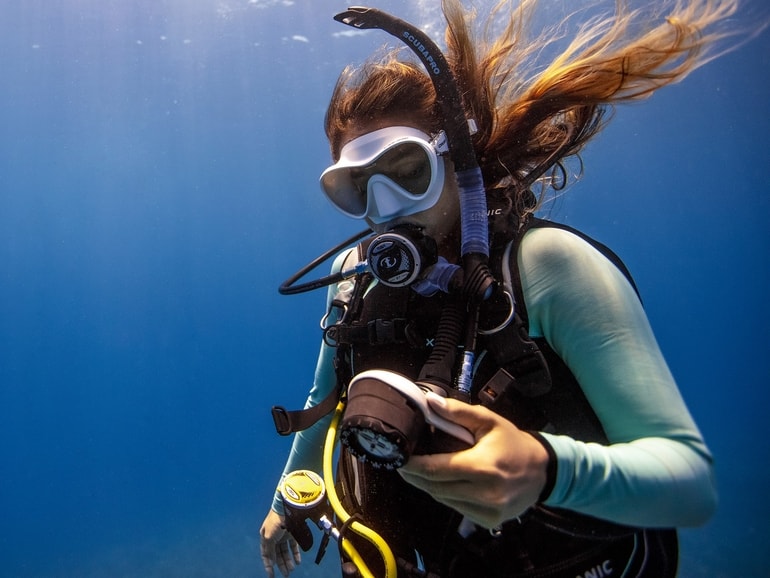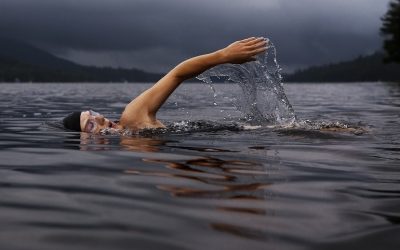No one wants to be that unlucky soul who has to end the dive for everyone by being low on air. As many places around the world require that you have a professional guiding you, the other divers in your group cannot just stay underwater while the guide brings you up. So in most cases, an end to your dive means an end to everyone’s dive. Now, first thing’s first – in every group of divers, someone has to be the one who gets low on air first. If any other diver would be foolish enough to show disapproval for that, it reflects much more poorly on the person judging than on the person being judged.
But alas, sometimes that perception of being judged can weigh heavily on us, whether or not it is the reality. Even if you rightly don’t care what others think, you surely would still like to increase your own dive time by sucking less air. You may even be tempted to lie to your guide about how much air you have remaining, which, coming from this dive professional’s perspective, happens surprisingly often (please don’t ever consider doing this).
There is, however, some good news. Most every diver can employ certain strategies to decrease air consumption and enjoy longer dive times. Given the correct techniques and some practice, you may see significant improvements in a short time.
Change What You Can, Accept What You Can’t
It is generally wise advice in life to focus on those things we can change, and accept those things we can’t. Air consumption in diving is no different. Take, for example, the simple fact that people with bigger lung volume will naturally take bigger breaths than people with smaller lung volume. Men tend to have bigger lungs than women, and so you may have noticed that, generally speaking, female divers are better on air than males. Also, people with smaller physical builds usually suck less air than people with larger physical builds. This is why 10 year old kids can dive using a tank almost half the size of an adult’s, yet still finish the dive with more air. So, if you are a big-bodied, adult male, it can be like starting a race 20 meters behind everyone else – you are at a disadvantage to begin with. And you should certainly not beat yourself up for not being able to change what you physically cannot (I will refrain from making some off-color joke about certain medical procedures you can get done cheaply here in Thailand).
However, those factors are only a small part of the overall picture. For the remainder of this article, let’s focus on some key elements that are in our power to change.
Buoyancy Control
It comes up again and again in any conversation about improving your dive skills. There is simply no more important factor in determining a good diver than the diver’s ability to maintain good buoyancy control. In the same respect, there is probably no single more important factor to improve any diver’s air consumption. Having good control of our buoyancy means we expend less effort at every stage of the dive. Less effort expended means less air consumed. That is why good buoyancy control can make a huge difference in our air consumption.
As we already have a detailed article with tips to improve your buoyancy control, I will only offer a short description of some key points here. Please refer to the full article for more in-depth explanations:
- Become natural at using your breathing to control small changes in your buoyancy (as opposed to relying too much on adjusting the BCD).
- Calculate your optimal amount of weight to ensure you don’t dive over-weighted.
- Maintain proper trim (body position) by lying completely horizontally and keeping your arms stationary, and eliminating all unnecessary movements.
Perfecting each of these points may take some practice, but at the end of the day you will notice vast improvements in your air consumption and overall dive experience.
Breathing Techniques
If you want to use less air, why not go right to the source? Although we should never breathe in such a way as to make ourselves feel starved for air, what you can do is make a conscious effort to take deep, slow breaths. Start by counting the number of seconds it roughly takes you to inhale and exhale a breath during a dive. You can achieve some significant improvements in your air consumption by drawing out those times, particularly for the exhale. That makes logical sense, as the more time you are using to let out a breath is more time that you are not actually consuming the air from your tank. Try aiming for 4-6 seconds each time you inhale and exhale. Taking deep breaths will also ensure you completely expel the air in your lungs, reducing dead air space and allowing your body to process oxygen more efficiently.
I find that in this respect, diving can be compared to meditation. In each activity, you must maintain focus on deep breathing in an effort to slow yourself down. If our mind is racing, it means we are not in a very relaxed state. In diving, this means we are bound to burn through our air. One of the great joys of diving is the feeling of total relaxation we can achieve. You can help yourself get there by focusing more on your breathing, slowing everything down, and relaxing your body and mind. Making a conscious effort to take deep breaths and slow down your breathing will lower your air consumption, improve your dive times, and enrich your overall diving experience.
Finning Styles
From the time you started diving, most likely you defaulted to using the flutter kick. That is the standard up-and-down leg motion, alternating your legs each time, that you likely use whenever you swim. Maybe you noticed, however, that your professional guide will rarely if ever use that type of finning style. Instead, most dive professionals utilize the more relaxed frog kick when taking a leisurely swim around the dive site. Instead of the more powerful thrusts of the flutter kick generated from your hips, the frog kick uses small and gentle movements mostly in your lower legs and ankles. If you aren’t familiar with this type of finning style, this very short video will best demonstrate it:
As we know already, less effort expended means less air consumed. Normally, our goal when diving is to go slowly, and the frog kick is a nice way to minimize our effort given a relaxed pace. On the other hand, if you find yourself in a hurry to get somewhere underwater due to any kind of urgent situation, then the flutter kick is definitely the way to go. It is faster and more powerful. But again, as most of the time our goal in diving is to be slow and relaxed, you should generally stick with the frog kick.
If you have tried the frog kick but find yourself more comfortable or stable with the flutter kick, then the underlying issue very well may be a lack of good buoyancy control. Many divers unwittingly rely on a flutter kick to correct for being negatively buoyant. As you are constantly moving your legs up and down, you can actually kick yourself up continuously to cancel out the effects of being slightly negative. If you switch to a frog kick in this state, you may feel yourself sinking and out of control. Instead of correcting the underlying issue of bad buoyancy control, many divers stick with the flutter kick, hardly realizing they are wasting unnecessary effort in doing so. If this sounds at all familiar to you, it is important to revisit the previous point about maintaining good buoyancy control. Once you correct the underlying issue and can easily maintain neutral buoyancy, the frog kick becomes a much simpler matter of practice and muscle memory.
Depth
It is worth a quick reminder that, due to ambient water pressure surrounding us when we dive, all divers consume air faster the deeper we go. Therefore, staying shallower means you will have a longer dive time. Much of the time, it is not entirely necessary to go very deep to see large amounts of sea life. In fact, corals tend to grow more abundantly at shallower depths where there is more sunlight, fueling the photosynthetic process of its cohabitant algae. More light also means more vibrant colors, and better conditions for photography or videography. So feel free to have a chat with your dive operator to seek out opportunities to dive shallower sites if you want an easy fix for enjoying longer dives.
Tank Size
For a simple, quick and dirty way to increase your dive time, why not just strap on a bigger tank? Many divers may not even be aware of the possibility to rent bigger tanks from the dive operator, even though it is common to have them available. Many shops have 15 liter tanks on offer, in comparison to the normal 12 liter tanks. That is enough to potentially increase your dive time by more than 20%. There is usually an extra cost involved to rent the bigger tank, but it could be well worth the expense, especially for those of us who are biologically inclined to suck more air.
Experience
Diving is no different than any other activity – the more you practice, the better you get. If you are serious about improving your air consumption, take every opportunity to get as much experience diving as you can. Some of the preceding tips, such as buoyancy control, breathing techniques, and finning styles, take a bit of practice to perfect. Also, the more you dive, the more generally comfortable you will feel. This will naturally improve your air consumption, as even any small stress you experience while diving will make your heart pump faster and in turn increase your breath rate. Removing those stressors by becoming comfortable through experience will help you enjoy longer, more relaxed dives.
Final Thoughts
While some of us are genetically predisposed to gulping down more air than others, we can still employ techniques that will significantly help improve our dive times. Start by working to perfect your buoyancy control, and continue by utilizing a deep, slow breathing technique and the frog kick finning style. If you want some immediate solutions to extend your dive time, you can always try to dive shallower sites and use a bigger tank. Finally, gain all the dive experience you can to put these tips into practice, and become completely comfortable underwater. Just give it some practice, and you are bound to see improvements before too long.




0 Comments